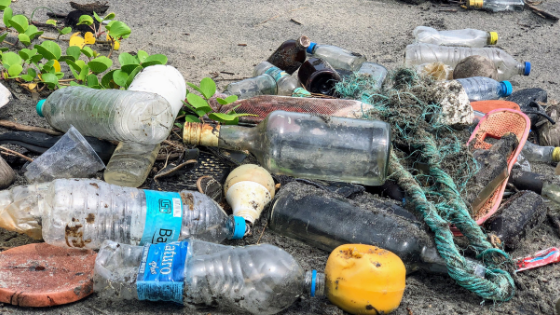June 17, 2019
By Stephie Hennekam
Pollution from plastic, it affects us all and it affects us entirely: our outside world (environment) as well as our inside world (body).
Plastic; once our go-to friend for carrying items, going shopping, storing food, throwing garbage, etc should now be ‘de-friended’. The use of plastic harms Mother Earth. And by harming her, we harm ourselves.
There’s so much to say about plastic, and too much to cover in a single blog post. I chose to discuss two problems caused by plastic that are important to me. I live by the ocean in Bali and walk the beach daily, so I see the impact of the plastic in our oceans and it’s not a pretty sight. Secondly, working for Richer Health made me realise how big, though invisible, the impact is of having plastic around our homes.
Being a firm believer in change, you can find some suggestions on how you can make a difference to reduce your use of plastic. Yeah!

Photo Credit: Unsplash.com
1. PLASTIC IN OUR WATER
There’s a huge, swirling pile of trash floating in the Pacific Ocean known as the “Great Pacific Garbage Patch”. It is growing faster than expected and is now about 1.6 million square kilometers in size – more than double the size of Texas. Every year 5 to 14 million tons of plastic flow into our oceans straight from the coastal areas.
This patch of plastic consists of large pieces of plastic people use on a daily basis i.e. water bottles, fishnets, plastic wraps from food, cups, flip flops, straws, toothbrushes, etc. These bigger plastic chunks slowly degrade to smaller plastic particles invisible to the eye.
Sadly, both big and small pieces get ingested by marine and freshwater species. The bigger pieces of plastic waste are often the cause of death when fish and marine mammals get caught up in them, ingest them or choke on them.
The tiny plastic particles are so small they get swallowed easily by all ocean and freshwater life. Scientists have found plastic in more than 114 water species. More than half of those end up on plates in many households and thereby in many bodies.
The ‘good’ news? Most microplastics seem to remain in the guts of fish and do not move into their muscle tissue. That being said, we need to be concerned about the impacts of marine plastics on human health because they are omnipresent and eventually degrade into nano-plastics. These tiny plastics penetrate cells and move into tissues and organs.
Today, researchers lack analytical methods to identify nano-plastics in food, so there is no data (yet) on the effects of absorption by humans. But let’s be real, plastic doesn’t occur in our bodies naturally. Would that be a good thing?
In short, the circle of life for plastic goes like this: people use plastic – plastic becomes garbage – garbage gets dumped into the ocean – all aquatic life is prone to (unconsciously) absorb (nano)plastic – people catch plastic-infused fish – people buy & eat this plastic-infused fish – impact on human health … BIG question mark.
Fish and other aquatic life, whether or not caught in the wild, whether or not from the ocean or freshwater, most likely comes with a side of nano-plastic.
2. PLASTIC IN OUR HOME – NOT THE KIND OF FIBRE WE WANT
Our homes are that infested with plastic that when we have a meal at home, it too, comes with a daily dose of plastic fibre. And that’s not the kind of fibre we want.
Moreover, plastic comes in many forms and contains a wide range of additives—pigments, ultraviolet stabilizers, water repellents, flame retardants, stiffeners such as bisphenol A (BPA), and softeners called phthalates—that can leach into their surroundings.
Plastic from carpets, clothes, and furniture are sources of tiny plastic fibre fragments that get swept up as dust. Many of these eventually find their way into our bodies while we enjoy our meals.
How do we know all this? Scientists set up Petri dishes next to meal plates. The plastic fibre fragments swirling in the air got caught in the Petri dishes which made it possible to measure how much plastic fibre we consume on average. The numbers are quite alarming; it seems that we ingest even more plastic having a meal at home than one would get from eating fish. Yikes!
Stretched out over a longer timeline, the data suggests that every single year, approximately 14,000 and nearly 70,000 individual pieces of tiny plastic are consumed.

Photo Credit: Unsplash
HOW CAN YOU MAKE A DIFFERENCE?
Research scientist Britta Denise Hardesty says: “Plastic pollution in the ocean is visible and trackable. We can definitely make a difference in how we vote with our pocketbook and think about each decision we make, whether we take our own bags to the supermarkets, refuse straws, bring our own coffee cups, accept single-use items or think about mindful alternatives.”
More ways to make a difference:
- Ban plastic from your home, start with taking a closer look at your bathroom products. Steer clear from all products containing polyethylene, polypropylene and polyethylene terephthalate. Watch this Nat Geo video to find out more;
- More ways to detoxify your home: read this blog and this blog;
- Only use biodegradable garbage bags;
- Take a pledge to refuse single-use plastics on natgeo.com/planetorplastic;
- Learn! Watch documentaries like “A Plastic Ocean“. Choose one of the suggestions to take action on, on their website;
- Learn about awesome ways people re-use and recycle plastic to their benefit to come up with your own idea. Check out this uplifting story about “Dr. Plastic” in Indonesia. Or learn how we avoid using plastic in the Green Moustache Organic Cafes.
If you enjoyed this blog, sign-up for our newsletter to receive future updates.
RESOURCES:
1. National Geographic: We know plastic is harming marine life, what about us?
2. Phys Org: Plastics in oceans are mounting, but evidence on harm is surprisingly weak
4. Environmental Pollution: Low levels of microplastics (MP) in wild mussels indicate that MP ingestion by humans is minimal compared to exposure via household fibers fallout during a meal; Ana I. Catarino
5. CNN.com: Great Pacific Garbage Patch now three times the size of France

Stephie Hennekam likes to think of herself as a knowledgeable foodie, wandering traveler, teacher, active yogi, lover of nature, free spirited writer & life long student. She loves going off the beaten path, following her (gut)- feeling and isn’t shy to try new stuff. After all, nothing beats experiencing something yourself.
As a former university college teacher, researcher, independent (sports)dietitian and jack of all trades at a vegan restaurant, she has now discovered her life goal of teaching & helping others to work towards a healthy, energised life filled with love, peace & happiness.


Comments